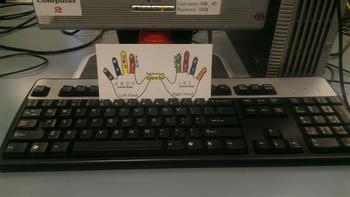

What is the Correct Hand Position for Typing? When your overall position is correct, you can type on the keyboard continuously with speed and precision without feeling sore fingers or hands. Ergonomic Monitor Setup and body posture (Source: Pixabay) However, experts point out that your hands, shoulder, and body should align with the keyboard to increase productivity. Similarly, assuming correct hand posture means you can reach each key within a flick of time, helping with typing faster. Therefore, the proper hand position is essential to ward off health problems. MedilinePlus.Gov reports that carpal tunnel syndrome is estimated to affect 1 to 5 percent of adults annually, with the incidence of CTS and repetitive injury rising, with 1-3 cases per 1000 subjects yearly.Īlthough cubital tunnel syndrome is less seen than carpal tunnel syndrome, it has risen, especially among computer users. When you bend the elbow often, the ulnar nerve gets irritated or compressed inside your elbow. Pressure on a nerve in your wrist leads to tingling, numbness, and pain throughout the palm, caused by wrist overuse. Problemĭamage to muscles, tendons, or nerves is caused by repetitive motions such as typing, moving the mouse, writing, etc. The American Academy of Orthopaedic Surgeons points out that RSI, carpal tunnel syndrome (CTS), and cubital tunnel syndrome are more familiar to users with poor typing practice. Anatomy of the carpal tunnel (Source: Wikimedia) Poor typing and posture can lead to many problems, including repetitive strain injury (RSI) of muscles and tendons. Most computer users make the mistake of incorrectly resting their hands on the keyboard, affecting their productivity and health. In short, yes! A correct hand position will be a game-changer when it comes to typing. What is the Correct Hand Position for Typing?.I just want to know your thoughts on why these seemingly suboptimal placements (particularly "c", "b", "0", and "6") are 'recommended'. Of course I understand that you can (and many do) have unique styles of typing with equal or better speeds than 'traditional' touch typists. Allows my ring finger to only type "0" so typing something like "10-20" uses different fingers for "0" and "-".


My finger placement (with differences highlighted) Widely-recommended touch typing finger placement Below are my justifications for my differing finger placements. I can't understand why some of the finger placements are 'recommended' (please tell me if you know!). I've analysed the widely-recommended touch typing finger placements against my own as well as the frequency of various bigrams (2-letter combinations) in the English language.


 0 kommentar(er)
0 kommentar(er)
